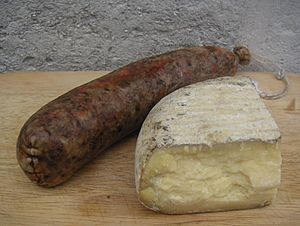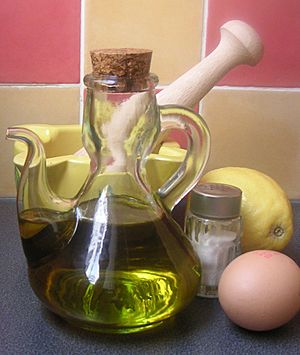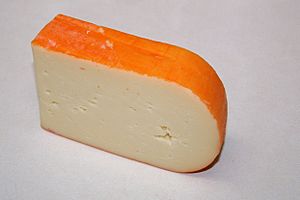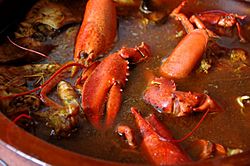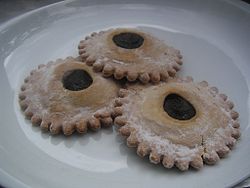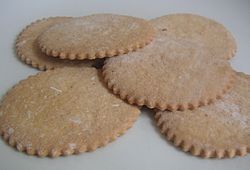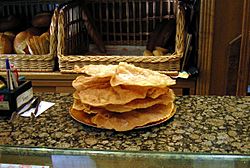Cuisine of Menorca facts for kids
Menorcan cuisine is the delicious food and drinks found on the island of Menorca.
Menorca is a rocky island in the Balearic group, part of Spain. It has a Mediterranean climate, which means mild weather. Strong winds in the north bring sea salt to the fields where cows graze. This salt gives their cheese a special taste! Seafood is very important here. The island also has horses, pigs (for tasty meats), and cows (for milk and cheese). Farmers grow many different Mediterranean fruits and vegetables. Over time, different groups of people who visited or lived on Menorca, like the English, added their own touches to the food. For example, they brought plum cake and puddings. Menorcan food is often simple, using fresh ingredients from local gardens, meat from the island, and fish caught that same day. Olive oil is also a key ingredient, even though it's not made on Menorca.
Menorcan food is usually simple and changes with the seasons. It relies a lot on fishing, especially for crabs, clams, and squid. Farmers grow many kinds of fruits and vegetables, but only enough for the islanders to eat.
Long ago, there were so many goats that people only ate them if other food ran out. Today, goat meat is a special treat. Rabbit is another common food. In the 1600s, the English tried to bring deer and hares to the island, but not many are left now. However, rabbits and different birds are still hunted or raised for food.
Contents
What Makes Menorcan Food Special?
The first written notes about Menorcan food appeared in 1891. Archduke Ludwig Salvator of Austria wrote about some typical dishes, but he didn't share any recipes. Later, in 1923, Pedro Ballester published a book called De re cibaria. This book shared many popular recipes and cooking traditions from the island.
Mediterranean crops greatly influenced the food. This meant using lots of olive oil, wine, beans, and salted foods. Arab influences are also important. French and English cooking styles also added to the mix because these countries controlled the island in the 1700s.
Even today, Menorcan food changes with the seasons. People use different ingredients and recipes depending on the time of year and special holidays.
Main Ingredients
Here are some of the most common ingredients you'll find in Menorcan cooking:
- Fish: pearly razorfish, sheepsheads, stingrays, scorpionfish, groupers, goosefish, and salted cod.
- Seafood: mussels, cockles, squid, cuttlefish, octopus, shrimp, scampi, lobster, crab, sea snails.
- Vegetables: tomatoes, onion, garlic, chili pepper, aubergine, courgette.
- Legumes: Dry white string beans (called guixons).
- Greens: chard, spinach, peas (called fesols), cabbage.
- Fruits: figs, peaches, apricots, pears, grapes, oranges, lemons.
- Nuts: dates, almonds, pine nuts.
- Meat: chicken, rabbit, pork, beef, and various cold cuts.
- Mushrooms: saffron milk cap, dried mushrooms.
- Other: olive oil, bread, honey, capers, wine, eggs, snails, ricotta, figat (a fig cake).
Famous Menorcan Foods
Mayonnaise
Many people believe that mayonnaise was first made in Mahón, a city in Menorca. The story goes that this creamy sauce, made from eggs and olive oil, was taken to France after the French briefly controlled the island. Another idea is that it came from a French town called Maiona or Baiona. Either way, mayonnaise, with or without garlic, has been a popular sauce in Menorcan cooking for a very long time. It's used on its own or as an ingredient in other dishes.
Mahón Cheese
Menorca is famous for its special cheese called Mahón cheese. This cheese has a special status in Spain, meaning it's a unique product from this region. It's a pressed cheese with a distinct orange color and rounded corners. In 1985, it was officially named queso Mahón. Later, in 1998, Menorca was added, making the full name Mahón-Menorca. You can find four main types of Mahón cheese, depending on how long they've been aged: mild, semi-mature, mature, and aged. Fresh cottage cheese, similar to ricotta, is also made in local dairies.
Menorcan Cold Cuts
Most pork cold cuts made in Menorca, except for sobrassada, have roots in old Roman traditions. Pigs are usually prepared in winter, a process called porquejades. Some of these products get their black color from adding blood.
Like in Catalan cuisine, only a few spices are used, but they give each product a unique taste. Common spices include black pepper, white pepper, paprika (in sobrassada), anise, cinnamon, and salt. Sometimes, Mediterranean spices like thyme, rosemary, and oregano are also added.
- White botifarra' is a grayish-brown sausage that doesn't contain blood. It's often shaped like a ball and used in soups like escudella. It's usually eaten cooked, often fried.
- Black botifarra' has the same ingredients as the white version but includes pig blood. It's a thinner sausage, often fried with sobrassada, and can sometimes be eaten raw.
- Camallot is a cooked, black, and very fatty sausage. It usually contains minced pork, pig's blood, black pepper, a little paprika, and anise. It looks different because it's made inside a pig's leg, which is where its name comes from. You can eat it raw in thin slices or cooked.
- Carnixulla is a cured raw sausage made from chopped lean meat mixed with small pieces of bacon. It's seasoned with salt, pepper, and sometimes other spices. This sausage dries inside the intestine. Unlike sobrassada, it doesn't go through fermentation. This cold cut is unique to Menorca and might be the oldest one on the island.
- Menorcan sobrassada' is usually thinner and less spicy than the one from Mallorca.
Traditional Dishes
Vegetables, Legumes, and Greens
Menorcan food is very Mediterranean, with lots of different vegetables. The island has always grown most of its own fresh produce. This is thanks to farming, which still covers about half of Menorca's land today. Important vegetables include tomatoes (for salads and stir-fries), onions, green peppers, red peppers, and garlic. Roman lettuce is used for salads. Mediterranean vegetables like eggplant (which is small and white inside in Menorca), zucchini, and artichoke (a small, purple local type) are fried, stuffed, or baked.
Fruits are also plentiful, especially figs. Figs are even used in savory dishes, like the oliaigua soup.
Local green vegetables are cooked in many ways. Common ones include guixons (string beans), habas (broad beans), lentils, and chickpeas.
Mushrooms are very popular, eaten baked, fried, or with sauce to go with meats. Wild asparagus is also enjoyed in oliaigua soup or simply with an omelet.
Olive oil is used for cooking these dishes and in pastries. Olives and local capers are also enjoyed. Although there used to be many olive trees in Menorca, they are not grown much anymore.
Some Menorcan dishes with these ingredients are:
- Oven-baked eggplant: Thin slices of local eggplant are baked with shredded bread, minced garlic, and basil. A similar dish, carbassonada, is made with zucchini. Stuffed zucchini and baked tomatoes are also traditional.
- Oliaigua: This was originally a very simple soup, eaten when ingredients were scarce. In summer, it's often eaten with figs.
- Perol: Layers of sliced potatoes and tomatoes are baked with shredded bread, garlic, and basil. Sometimes, fish like gilt-head bream can be added between the layers.
- Cuttlefish with fesols' (peas): A stew with fresh cuttlefish and peas. It's often served as a tapa. Sometimes, small meatballs are added.
Many savory dishes are made with wheat flour. Often, bread dough wraps around local produce. Examples include rubiols (savory pastries), Menorcan flaons (salty pastries filled with cheese), and agujas or croissants (half-moon shaped pastries filled with sobrassada). Formatjades are popular around Easter. Salty cocas (flatbreads) are usually rectangular, open or closed, and can be filled with stir-fried vegetables or peppers, and sometimes meat or fish. On Christmas Eve, people often eat bread rolls filled with diced meat, soaked in milk, and baked.
Fish and Seafood
Because Menorca is an island, seafood is eaten a lot. Both whitefish (like Goosefish or Hake) and Oily fish (like Atlantic mackerel or sardine) are used, always very fresh. Many Menorcans own boats and go fishing on weekends or during summer trips around the island, often cooking their catch right on board. Scorpaena (scorpionfish) is a popular and common fish. Rajiformes (rays) are also enjoyed, baked, grilled, or in paella.
Many types of seafood, shells, and mollusks are used. Like land products, these change with the season. They are cooked in pots, stews, with rice, or sometimes in savory pies. Menorca has a long tradition of eating various fish, and even octopus or squid, shaped into meatballs. The cod ab burrida, a dish made by mixing cod with a garlic and oil dressing, is similar to dishes in Catalonia and other nearby areas.
Some Menorcan fish and seafood dishes are:
- Stuffed calamari: Baked or cooked in a saucepan, this dish is known for its delicate flavors.
- Lobster stew: Not long ago, this bread soup was a simple dish for fishermen because lobsters were easy to find in Menorca. Bits of lobster are added to onions, tomato, garlic, and parsley, then boiled. Caldereta is the most famous Menorcan dish internationally, and the lobster version is the most iconic. Other stews are made with fish, often rock fish like grouper.
- Baked common cockle: Covered with shredded bread, garlic, and parsley.
- Cabracho (scorpion fish) meatballs: Made with a sautéed sauce. Some people add a little grated Mahón cheese to the meatballs. You can make meatballs with other fish too, especially those used in soups. Meatballs in meat sauce, sometimes with pine nuts, are also prepared and can be eaten as a tapa.
Meats
Raising pigs is common on the island because they are easy to care for, and traditional sausages are very popular. Cattle farming also provides milk (for cheese and other products), meat, and hides, which local leather craftsmen use. An old recipe is Feixets or Chaplain’s Partridges, which are thin veal rolls filled with boiled egg, bacon, and sobrasada.
Lamb, chicken, and rabbit are also eaten. There are local types of chicken and lamb.
Hunting is limited now, mainly for rabbits and birds. Rabbits are hunted with dogs, including a local breed called the Rabbit’s Dog, and shotguns. Birds are hunted using decoys and special netting.
Snails are also part of Menorcan food. They can be prepared simply with alioli (garlic mayonnaise) or in more complex dishes, like snails with sea crab.
Some Menorcan dishes with meats or sausages are:
- Arroz de la Tierra (Rice of the Land): This dish isn't made with rice, but with wheat that's crushed and baked with different sausages. It's similar to African couscous.
- Fried lamb or fried pork: Sometimes called Frit Menorquí by locals.
- "Macarrones" with gravy: This dish uses penne pasta and meat. It's cooked in a way that mixes Italian and Catalan styles. It also has a British influence, as gravy is a simple meat sauce often served with pasta.
Delicious Desserts and Pastries
Menorcan baking, pastries, and desserts combine ideas from Jewish, Arabic, and English cultures. The short time the French spent on the island led to the creation of "Gató," a cake made with almonds using French techniques. From the British, islanders learned to love puddings. They use a lot of Catalan cream and Italian-style meringue to decorate desserts. This love for very sweet recipes is shared with other countries in the southern Mediterranean.
- "Amargos" (Bitters): Cookies made with egg whites and almonds, similar to Italian Amaretti.
- "Buñuelos de Todos los Santos" (Fritters of All Saints): Made with soft Mahón cheese for All Saints' Day.
- "Carquinyoli Menorquines" (or "Carquinyols de Es Mercadal"): Square-shaped, dry, and hard cookies with almonds, egg white, sugar, and flour.
- "Coca de Tomate de Ciudadela": A flatbread with tomato slices, garlic, parsley, sugar, and crushed cookies.
- "Coca Bamba" (or "Coca de San Juan" in Ciudadela): A thick, tall, snail-shaped flatbread with boiled potato. It's eaten for breakfast, as a snack, or with hot chocolate during local festivals. Old Cocas can be used to make "Pudin." Smaller, round "Coquitas" are made with the same recipe, topped with apricots or other seasonal fruit.
- Crespells of Menorca: Flower-shaped cookies with about twelve petals, covered in fine sugar. They are filled with jam or a mix of cottage cheese and lemon. They have a hole in the middle to show the filling.
- Crespellets (or "Crespellines"): Dry, round, large, and thin cookies with a wavy edge.
- "Cuscussó": Looks like a loaf of bread covered with candied fruit and pine nuts. The dough is made from rustic bread soaked in water with sugar, then mixed with almonds, cinnamon, lemon peel, and kneaded again.
- "Ensaimada": A spiral pastry made in both Mallorca and Menorca.
- "Formatjades de Requesón": Sweet Formatjades filled with a mix of cottage cheese and lemon peel.
- "Alayor" cookies: Round buns with a "closed hole" in the middle. The dough has a bit of anise. They are mainly eaten for breakfast and snacks, dipped in milk.
- "Gató": A type of cake where chopped almonds replace flour.
- "Macarrones de la Ciudadela": Small white cookies made with egg white, lots of sugar, and sometimes almonds. They are shaped like a six-pointed flower.
- "Orelletes": Fried dough that is thin, irregular, and crispy. They are flavored with muscat wine and served with warm honey.
- Menorcan "Pastissets": Five or six-petaled flower-shaped cookies, covered with fine sugar. They are made with lard, flour, egg, sugar, and lemon zest.
- "Pudin de Requesón Menorquín" (Menorcan cottage cheese pudding): Made with Alayor cookies and often decorated with raisins and pine nuts.
- Pudding of Coca Bamba: Sometimes made with Ensaimadas; it's a firm custard dessert that can be cut into pieces.
- Grapes and cheese: A simple dessert.
- "Rubiol": A sweet pastry similar to a sweet Pastisset from Valencia, popular in Mallorca and Menorca.
- "Rissats": Rectangular biscuits decorated with wavy lines made with a fork. They are similar to Crespellines.
- "Tatis": Like the Catalan Carquinyolis but with chocolate.
- "Turrón Quemado" (Burnt Nougat) from Mercadal: A unique type of nougat.
- "Tortada": A cake made of chopped almonds, common in Spain. In Menorca, it's often covered completely with burnt egg yolk and meringue, and sometimes sugar. This decoration is very typical of the island and is found on Monas de Pascua (Easter cakes), birthday cakes, and Brazos de Gitano (Swiss rolls), which are often filled with egg yolk if not Catalan cream.
Food Festivals
CuinaArt Menorca is a food fair held every April since 2007. It's a great place to see and taste Menorcan products. The fair includes displays, discussions, tastings, and talks, and is open to everyone.
Images for kids
See also
 In Spanish: Gastronomía de Menorca para niños
In Spanish: Gastronomía de Menorca para niños


